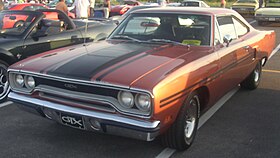Plymouth GTX
| Plymouth GTX | |
|---|---|
 |
|
| Overview | |
| Manufacturer | Chrysler Corporation |
| Production | 1967–1971 (44178 units) |
| Assembly | St. Louis, Missouri, United States |
| Body and chassis | |
| Class | Muscle car |
| Layout | FR layout |
| Platform | B-body |
| First generation | |
|---|---|
 |
|
| Overview | |
| Also called |
Plymouth Belvedere GTX |
| Production | 1967 |
| Body and chassis | |
| Body style | 2-door coupe |
| Related |
Dodge Charger Plymouth Belvedere Plymouth Satellite |
| Powertrain | |
| Engine | 426 cu in (7.0 L) Hemi V8 440 cu in (7.2 L) RB V8 |
| Transmission | 4-speed manual 3-speed automatic |
| Dimensions | |
| Wheelbase | 116.0 in (2,946 mm) |
| Third generation | |
|---|---|
| Overview | |
| Production | 1971 |
| Body and chassis | |
| Body style | 2-door coupe |
| Related |
Dodge Charger Dodge Coronet Plymouth Road Runner Plymouth Satellite |
| Powertrain | |
| Engine | 426 cu in (7.0 L) 426 Hemi V8 |
| Transmission | 4-speed manual 3-speed automatic |
| Dimensions | |
| Wheelbase | 115.0 in (2,921 mm) |
The Plymouth GTX was an automobile introduced as the Belvedere GTX in 1967 by the Plymouth division and positioned as a "gentleman's" muscle car.
Plymouth Belvedere
The GTX was to be an exceptional blend of style and performance. What differentiated it from a normal Belvedere was its special grille and rear fascia, shared with the Satellite, chrome "pit stop" fuel filler cap and optional racing stripes. For the performance aspect of the vehicle, a heavy duty suspension system was made standard. Standard too was Plymouth's 440 cu in (7.2 L) V8 called the "Super Commando 440". The engine was rated at 375 hp (280 kW). Buyers in 1967 could pay an extra US$546 and replace the 440 with Chrysler's 426 cu in (7.0 L) Hemi. The 426 was nicknamed the "Elephant."
In 1968, after one year of production, the GTX was given a completely new look. A new hourglass body replaced the more box-like body of 1967. The Road Runner was introduced by Plymouth as a performance version of the Satellite. There were major changes made in the design of all the Plymouth B-bodies. The Road Runner's base engine was the new 383 cu in (6.3 L) "Super Commando" V8 (renamed the "Road Runner 383"), while the high performance 440 was still standard in the GTX. The TorqueFlite automatic transmission was standard on the GTX, with it being a US$206 option in the Road Runner. The GTX used the Sport Satellite trim and was offered in two models, the two-door convertible and the two-door hardtop. The Road Runner used the Belvedere trim, and had less insulation and comfort items (padding, vinyl roof, trim), which reduced weight, helped produce better track times, and kept it in the low price field.
In 1969, the GTX's sales were hurt when the Road Runner was also offered in a convertible body style. The GTX received minor cosmetic changes, as well as the introduction of the optional Air Grabber hood (standard on Hemi-engined models), which made the openings running length wise down both sides of the hood functional. The standard 440 V8 was still rated at 375 hp (280 kW). The 69 GTX was the last year that the convertible model was available on the GTX (VIN RS27). Chrysler Corporation only made 701 GTX convertibles in 1969. Of those, eleven were equipped with the 426 Hemi; four 4-speeds and seven TorqueFlite automatics. The 1969 GTX also had standard black lower body side paint, replacing the dual, horizontal "racing" stripe on the lower sides of the 1968 model.
...
Wikipedia
